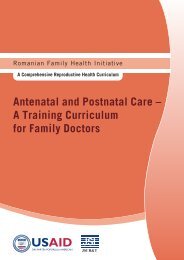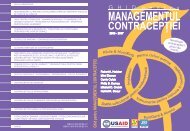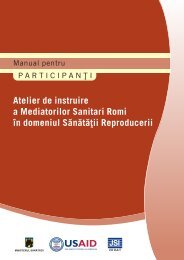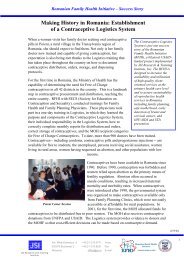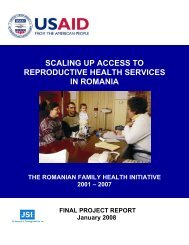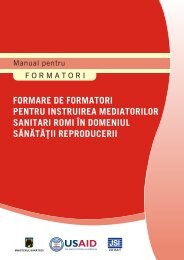Training of Roma Health Mediators in Reproductive Health
Training of Roma Health Mediators in Reproductive Health
Training of Roma Health Mediators in Reproductive Health
You also want an ePaper? Increase the reach of your titles
YUMPU automatically turns print PDFs into web optimized ePapers that Google loves.
the mother breathe more easily, but she may need to ur<strong>in</strong>ate more <strong>of</strong>ten because <strong>of</strong><br />
pressure on the bladder. (In the first birth, these signs can appear up to 4 weeks before<br />
delivery.)<br />
‣ What are the signs <strong>of</strong> labor?<br />
• Loss <strong>of</strong> mucus plug<br />
• Blood with mucous comes out <strong>of</strong> the vag<strong>in</strong>a.<br />
• A gush <strong>of</strong> water comes out <strong>of</strong> the vag<strong>in</strong>a (rupture <strong>of</strong> amniotic sac or “bag <strong>of</strong><br />
water” breaks)<br />
• Increased pelvic pressure and pa<strong>in</strong>ful regular contractions <strong>of</strong> the womb, every 20<br />
m<strong>in</strong>utes or less.<br />
Pregnant women should be advised to go to the hospital as soon as possible if any <strong>of</strong><br />
these signs <strong>of</strong> labor appear.<br />
Expla<strong>in</strong> the term ‘labor’ and describe the three stages <strong>of</strong> normal labor:.<br />
• Labor is the process by which a woman delivers her baby <strong>in</strong>to the world.<br />
• The first stage <strong>of</strong> labor starts with regular contractions <strong>of</strong> the womb, which become<br />
stronger and stronger and the <strong>in</strong>tervals between contractions become less. The baby is<br />
pushed downwards with each contraction and thus pressure is applied regularly on the<br />
cervix (mouth <strong>of</strong> the uterus or womb) so that it opens up and f<strong>in</strong>ally the baby moves<br />
down <strong>in</strong>to the vag<strong>in</strong>a (birth canal) and the mother feels she has to push. Usually labor<br />
lasts 10 to 20 hours or more when it is the mother's first birth, and from 7 to 10 hours<br />
<strong>in</strong> a woman who has already had the first baby. This varies a lot.<br />
Dur<strong>in</strong>g the first stage <strong>of</strong> labor, the mother should not try to hurry the birth. It is<br />
natural for this stage to go slowly. The mother should not try to push or bear down.<br />
She should change positions <strong>of</strong>ten or get up and walk about from time to time. She<br />
should not lie flat on her back for a long time.<br />
If the mother is frightened or <strong>in</strong> great pa<strong>in</strong>, she needs to take deep, slow, regular<br />
breaths dur<strong>in</strong>g each contraction, and breathe normally between them. This will help<br />
control the pa<strong>in</strong> and calm her. Reassure the mother that the strong pa<strong>in</strong>s are normal<br />
and that they help to push her baby out.<br />
• The second stage, <strong>in</strong> which the child is born, lasts from the dropp<strong>in</strong>g <strong>of</strong> the baby <strong>in</strong>to<br />
the vag<strong>in</strong>a (birth canal) until the baby passes through the vag<strong>in</strong>a and goes out from<br />
the mother’s body. Sometimes this beg<strong>in</strong>s when the bag <strong>of</strong> water breaks. It is <strong>of</strong>ten<br />
easier than the first stage and usually does not take longer than 1 hour. Dur<strong>in</strong>g the<br />
contractions the mother bears down (pushes) with all her strength. Between<br />
contractions, she may seem very tired and half-asleep.<br />
• The third stage beg<strong>in</strong>s when the baby has been born and lasts until the placenta<br />
(afterbirth) comes out. Usually, the placenta is detached from the wall <strong>of</strong> the uterus<br />
and comes out by itself 5 m<strong>in</strong>utes to an hour after the baby. The uterus contracts<br />
further to m<strong>in</strong>imize blood-flow and becomes tight.<br />
108<br />
RFHI/JSI <strong>Roma</strong>nia <strong>Tra<strong>in</strong><strong>in</strong>g</strong> <strong>of</strong> RHMs <strong>in</strong> <strong>Reproductive</strong> <strong>Health</strong> Session 6: Pregnancy



